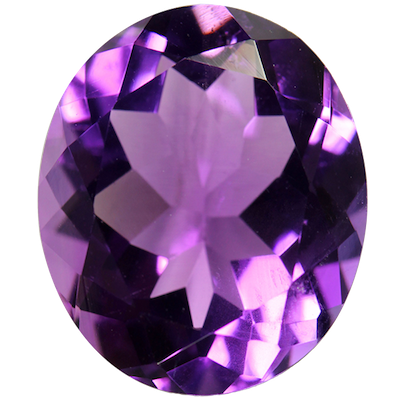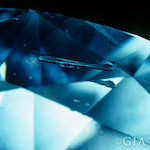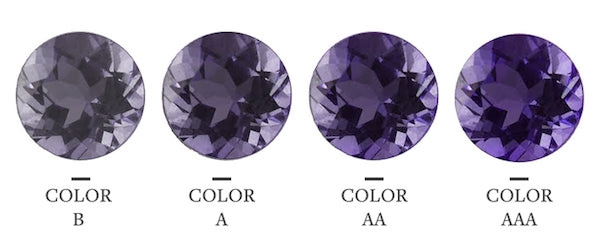Amethyst Grading
A popular purple quartz, amethyst, is purple or violet in color and synonymous with spirituality and healing. The stone is also regarded as a good luck charm, and purportedly channels harmony and equilibrium. Purple quartz is used to create all sorts of striking jewelry, from eye-catching amethyst earrings to amethyst engagement rings.
TABLE OF CONTENTS
How Are Amethysts Graded?
Amethyst differs from other gems in the sense that the price isn't linked to the carat weight of the stone. Instead, gemologists carry out amethyst stone grading by assessing its color--with amethyst clarity and the level and severity of inclusions taken into account too.
How to Grade Amethyst Purple Color
An amethyst's color grade determines its quality and value. Whilst all amethysts are purple they vary greatly in terms of their actual shade and hue. The gems typically range in color from a faint lilac to a rich purple with red and blue tones. Purple quartz with this coloring are referred to as Siberian Amethysts.

As a general rule, the deeper the shade, the better-quality the amethyst. Siberian Amethysts are considered the priciest gems. In comparison, an amethyst that is very pale or exhibits light or dark patches is considered less desirable and therefore will be less expensive.
How to Grade Amethyst Clarity
Amethysts are also graded in relation to their clarity. As Type 2 gemstone amethysts do tend to have inclusions (slight imperfections and characteristics within the gem). However, much purple quartz are eye-clean, which means although inclusions do exist, they aren't necessarily noticeable or visible to the naked eye.
Amethysts are prone to a few inclusions, some more common than others. Here's a rundown as to what you might find:
Common Inclusions:
- Fissures or feathers: internal crack.

- Negative crystals: small specks of foreign material trapped within the gem.

- Needles: long, thin crystals that look like needles.

Other Inclusions:
- Pinpoint: barely visible: minuscule mineral crystal within the stone.

- Indented Natural: dimple on the outer area.

- Chip: a nick found usually at the edge of the gem.

- Cavity: small and sometimes deep hollow.

- Etch Channel: a hollow tunnel that runs from the surface to the interior of the stone.
The Amethyst Grading Chart
Gemologists assign classification based upon the amethyst grading scale. Here's a brief guide to help you get to grips with the main different levels:
AAAA Grade
AAAA graded amethysts are considered high quality and are usually dark purple. Moreover, AAAA grade purple quartz has a brilliant-cut and contains no inclusions visible to the naked eye.
AAA Grade
AAA grade amethysts are typically medium to dark purple in color. If you look closely you might see slight inclusions within the stones.
AA Grade
Usually pale to medium purple, AA graded amethysts will have more in the way of inclusions, but the gems still look very pretty!
A-B Grade
A or B graded purple quartz are pale purple in color and will have more noticeable inclusions.

More About Amethyst Grades
Amethysts vary in price, and while you can look at the grading to ascertain the authenticity and value of the gem, you should also take a look at the stone itself. You don't necessarily need to buy an AAAA graded purple quartz to get a beautiful jewel.
Like most things in life, personal taste has a part to play when choosing jewelry. Look carefully at the color and clarity and examine the gem for noticeable imperfections. A heating technique can be used to eradicate unwanted brownish inclusions or to lighten the color if preferred.
Moreover, these treatments are totally safe and are done on the majority of semi-precious gemstones that are used to create jewelry. Heat treatment is a permanent way to improve the look of the gemstone.
Why Not Treat Yourself to an Amethyst?
Affordable, and a striking alternative to traditional diamonds, the purple quartz is a gem worthy of your attention. Try a pretty amethyst white gold ring or an attractive amethyst pendant on a delicate gold chain.
Amethyst wedding rings are considered a stylish and avant-garde choice. Regardless of the occasion, expert gemologists can help craft the perfect piece of jewelry.
FAQs
How is amethyst graded?
What is the best grade for an amethyst?
What does a highly graded amethyst look like?
Is amethyst an expensive gemstone?









